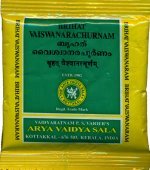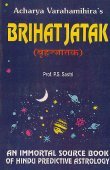Brihat, Bṛhat: 12 definitions
Introduction:
Brihat means something in Buddhism, Pali, Hinduism, Sanskrit, Marathi, Hindi. If you want to know the exact meaning, history, etymology or English translation of this term then check out the descriptions on this page. Add your comment or reference to a book if you want to contribute to this summary article.
The Sanskrit term Bṛhat can be transliterated into English as Brhat or Brihat, using the IAST transliteration scheme (?).
In Hinduism
Ayurveda (science of life)
Source: Wisdom Library: Āyurveda and botanyBṛhat (बृहत्) is a Sanskrit technical term translating to “lofty”, “solid”, “abundant” etc., and is used throughout Ayurvedic literature such as the Suśrutasaṃhitā or the Carakasaṃhitā.

Āyurveda (आयुर्वेद, ayurveda) is a branch of Indian science dealing with medicine, herbalism, taxology, anatomy, surgery, alchemy and related topics. Traditional practice of Āyurveda in ancient India dates back to at least the first millenium BC. Literature is commonly written in Sanskrit using various poetic metres.
Purana and Itihasa (epic history)
Source: Cologne Digital Sanskrit Dictionaries: The Purana Index1a) Bṛhat (बृहत्).—sāmans having the metrical form of Bṛhatī; for śrāddha;1 in connection with installing a new image.2
1b) A son of Mantraśarīra.*
- * Vāyu-purāṇa 67. 5.
1a) Bṛhat (बृहत्).—The place of Bṛhaspati in the maṇḍala.*
- * Vāyu-purāṇa 53. 59.
1b) A Jayādeva.*
- * Vāyu-purāṇa 66. 6.
Bṛhat (बृहत्) is a name mentioned in the Mahābhārata (cf. I.61.53) and represents one of the many proper names used for people and places. Note: The Mahābhārata (mentioning Bṛhat) is a Sanskrit epic poem consisting of 100,000 ślokas (metrical verses) and is over 2000 years old.

The Purana (पुराण, purāṇas) refers to Sanskrit literature preserving ancient India’s vast cultural history, including historical legends, religious ceremonies, various arts and sciences. The eighteen mahapuranas total over 400,000 shlokas (metrical couplets) and date to at least several centuries BCE.
Shaivism (Shaiva philosophy)
Source: Shodhganga: The saurapurana - a critical study (shaivism)Bṛhat (बृहत्) refers to one of the various leaves and flowers used in the worship of Śiva, according to the 10th century Saurapurāṇa: one of the various Upapurāṇas depicting Śaivism.—The text refers the following flowers and leaves to be offered to Lord Śiva [viz., Bṛhat][...]. It is stated that if a person offers these flowers to Lord Śiva, planting himself, the Lord Himself receives those flowers.

Shaiva (शैव, śaiva) or Shaivism (śaivism) represents a tradition of Hinduism worshiping Shiva as the supreme being. Closely related to Shaktism, Shaiva literature includes a range of scriptures, including Tantras, while the root of this tradition may be traced back to the ancient Vedas.
In Buddhism
Mahayana (major branch of Buddhism)
Source: Wisdom Library: Maha Prajnaparamita SastraBṛhat (बृहत्) refers to “(having a) tall (body)”, according to Mahāprajñāpāramitāśāstra (chapter 19).—Accordingly, “Furthermore, some say that generosity is the cause and condition (hetupratyaya) for obtaining the thirty-two marks. Why is that? [...] Because the gift serves to maintain life, one obtains the marks consisting of having long fingers (dīrghāṇguli) and the body tall and straight (bṛhat-ṛju-kāya). [...]”.

Mahayana (महायान, mahāyāna) is a major branch of Buddhism focusing on the path of a Bodhisattva (spiritual aspirants/ enlightened beings). Extant literature is vast and primarely composed in the Sanskrit language. There are many sūtras of which some of the earliest are the various Prajñāpāramitā sūtras.
Languages of India and abroad
Marathi-English dictionary
Source: DDSA: The Aryabhusan school dictionary, Marathi-Englishbṛhat (बृहत्).—a Large, bulky, big.
Marathi is an Indo-European language having over 70 million native speakers people in (predominantly) Maharashtra India. Marathi, like many other Indo-Aryan languages, evolved from early forms of Prakrit, which itself is a subset of Sanskrit, one of the most ancient languages of the world.
Sanskrit dictionary
Source: DDSA: The practical Sanskrit-English dictionaryBṛhat (बृहत्).—a. (-tī f.) [बृह्-अति (bṛh-ati)]
1) Large, great, big, bulky; वितरति बृहदश्मा पर्वतः प्रीतिमक्ष्णोः (vitarati bṛhadaśmā parvataḥ prītimakṣṇoḥ) Mālatīmādhava (Bombay) 9.5.
2) Wide, broad, extensive, far-extended; दिलीपसूनोः स बृहद्भुजान्तरम् (dilīpasūnoḥ sa bṛhadbhujāntaram) R.3.54.
3) Vast, ample, abundant.
4) Strong, powerful.
5) Long, tall; देवदारुबृहद्भुजः (devadārubṛhadbhujaḥ) Kumārasambhava 6.51.
6) Fullgrown.
7) Compact, dense.
8) Eldest, or oldest.
9) Bright.
1) Clear, loud (as sound). -m. Name of Viṣṇu; अणुर्बृहन् कृशः स्थूलः (aṇurbṛhan kṛśaḥ sthūlaḥ) V. Sah. -f. Speech; शिष्याय बृहतां पत्युः प्रस्तावमदिशद्दृशा (śiṣyāya bṛhatāṃ patyuḥ prastāvamadiśaddṛśā) Śiśupālavadha 2.68.
-tī 1 A large lute.
2) The lute of Nārada.
3) A symbolical expression for the number 'thirty-six'.
4) A part of the body between the breast and backbone.
5) A mantle, wrapper.
6) A reservoir.
7) The egg-plant.
8) Name of a metre.
9) A speech; दक्षां पृश्निं बृहतीं विप्रकृष्टां (dakṣāṃ pṛśniṃ bṛhatīṃ viprakṛṣṭāṃ) ...... गङ्गां गता ये त्रिदिवं गतास्ते (gaṅgāṃ gatā ye tridivaṃ gatāste) Mahābhārata (Bombay) 13.26.86; अनन्तपारां बृहतीं सृजत्याक्षिपते स्वयम् (anantapārāṃ bṛhatīṃ sṛjatyākṣipate svayam) Bhāgavata 11.21.4. -n.
1) The Veda; जामदग्न्योऽपि (jāmadagnyo'pi) ...... वर्तयिष्यति वै बृहत् (vartayiṣyati vai bṛhat) Bhāgavata 9.16.25.
2) Name of a Sāman; बृहत्साम तथा साम्नां गायत्री छन्दसामहम् (bṛhatsāma tathā sāmnāṃ gāyatrī chandasāmaham) Bhagavadgītā (Bombay) 1.35; cf. Ch. Up.2.14.1.
3) Brahman; बृहदुपलब्धमेतदवयन्त्यवशेषतया (bṛhadupalabdhametadavayantyavaśeṣatayā) Bhāgavata 1.87.15.
4) Devoted celibacy (naiṣṭhika brahmacaryam); सावित्रं प्राजापत्यं च ब्राह्मं चाथ बृहत्तथा (sāvitraṃ prājāpatyaṃ ca brāhmaṃ cātha bṛhattathā) Bhāgavata 3.12.42. (bṛhat, bṛhatā ind.
1) Greatly, highly.
2) Clearly, brightly)
Source: Cologne Digital Sanskrit Dictionaries: Shabda-Sagara Sanskrit-English DictionaryBṛhat (बृहत्).—mfn. (-han hantī hat) See vṛhat .
Source: Cologne Digital Sanskrit Dictionaries: Monier-Williams Sanskrit-English Dictionary1) Bṛhaṭ (बृहट्):—[from bṛṃh] in [compound] for bṛhat.
2) Bṛhat (बृहत्):—[from bṛṃh] mf(atī)n. (in later language usually written vṛhat) lofty, high, tall, great, large, wide, vast, abundant, compact, solid, massy, strong, mighty, [Ṛg-veda] etc. etc.
3) [v.s. ...] full-grown, old, [Ṛg-veda]
4) [v.s. ...] extended or bright (as a luminous body), [ib.]
5) [v.s. ...] clear, loud (said of sounds), [ib.]
6) [v.s. ...] m. Name of a Marut, [Harivaṃśa]
7) [v.s. ...] of a prince, [Mahābhārata]
8) [v.s. ...] of a son of Su-hotra and father of Aja-mīḍha, [Harivaṃśa]
9) [v.s. ...] m. or n. (?) speech (tām pati = bṛhaspati), [Śiśupāla-vadha ii, 26]
10) [from bṛṃh] n. height (also = heaven, sky), [Ṛg-veda]
11) [v.s. ...] Name of various Sāmans composed in the metrical form Bṛhatī (also with āneyam, bharad-vājasya. bhāradvājam, vāmadevyam, sauram), [Ārṣeya-brāhmaṇa]
12) [v.s. ...] Name of Brahman, [Bhāgavata-purāṇa]
13) [v.s. ...] of the Veda, [ib.]
14) [v.s. ...] ind. far and wide, on high, [Ṛg-veda]
15) [v.s. ...] n. firmly, compactly, [ib.]
16) [v.s. ...] brightly, [ib.]
17) [v.s. ...] greatly, much, [ib.]
18) [v.s. ...] aloud, [ib.] (also atā, [Atharva-veda])
Source: DDSA: Paia-sadda-mahannavo; a comprehensive Prakrit Hindi dictionary (S)Bṛhat (बृहत्) in the Sanskrit language is related to the Prakrit words: Bahaḍa, Biha.
Sanskrit, also spelled संस्कृतम् (saṃskṛtam), is an ancient language of India commonly seen as the grandmother of the Indo-European language family (even English!). Closely allied with Prakrit and Pali, Sanskrit is more exhaustive in both grammar and terms and has the most extensive collection of literature in the world, greatly surpassing its sister-languages Greek and Latin.
Hindi dictionary
Source: DDSA: A practical Hindi-English dictionaryBṛhat (बृहत्):—(a) large; big; huge; ~[ttara] larger, bigger.
...
See also (Relevant definitions)
Starts with (+191): Brihacchalka, Brihacchanti, Brihacchhringarabhra, Brihacchitta, Brihacchravas, Brihachchhitta, Brihadanga, Brihadaranya, Brihadaranyaka, Brihadbhanu, Brihadbhasa, Brihadbhattarika, Brihaddevata, Brihaddhakka, Brihadela, Brihadgaccha, Brihadgachchha, Brihadgola, Brihadgriha, Brihadguru.
Ends with: Dashabrihat, Kanvabrihat, Satobrihat, Shyenabrihat.
Full-text (+3477): Brihat-arthashastra, Brihatsaman, Brihat-sanrachana, Brihatkaya, Brihattika, Brihad, Brhat-goksura, Brihatprayoga, Brihat-upa-kunchika, Brihat-upakun-chika, Brihat nimbe, Brihadravin, Sukshmatikka, Tikka, Brihatphala, Brihat-gokshura, Brihat-bakula, Brihatkatha, Brihatkalpalata, Brihatkathavivarana.
Relevant text
Search found 97 books and stories containing Brihat, Bṛhat, Brhat, Bṛhaṭ; (plurals include: Brihats, Bṛhats, Brhats, Bṛhaṭs). You can also click to the full overview containing English textual excerpts. Below are direct links for the most relevant articles:
Katha Upanishad with Shankara’s Commentary (by S. Sitarama Sastri)
Verse 2.2.2 < [Adyaya II, Valli II - The soul after death]
Garga Samhita (English) (by Danavir Goswami)
Verse 8.13.77 < [Chapter 13 - A Thousand Names of Lord Balarāma]
Verse 4.19.47 < [Chapter 19 - A Thousand Names of Srī Yamunā]
Verse 2.1.17 < [Chapter 1 - Description of the Entrance in Vṛndāvana]
Three Different Accounts of the Origin of Adhikāranandin (Nandikeśvara)
Rig Veda (translation and commentary) (by H. H. Wilson)
Significance of the Moon in Ancient Civilizations (by Radhakrishnan. P)
8. Contributions of Varahamihira < [Chapter 2 - A Sceintific Outlook on Astrology]
1. Viryabala of Chandra (Verility of Moon) < [Chapter 6 - Relevance of Astrology]
Shrimad Bhagavad-gita (by Narayana Gosvami)
Verse 10.35 < [Chapter 10 - Vibhūti-yoga (appreciating the opulences of the Supreme Lord)]
Related products
(+12 more products available)





